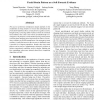271 search results - page 3 / 55 » Crime scene classification |
SIAMADS
2010
13 years 2 months ago
2010
We present a weakly nonlinear analysis of our recently developed model for the formation of crime patterns. Using a perturbative approach, we find amplitude equations that govern t...
WACV
2007
IEEE
14 years 1 months ago
2007
IEEE
The success of forensic identification largely depends on the availability of strong evidence or traces that substantiate the prosecution hypothesis that a certain person is guil...
AGILE
2009
Springer
14 years 2 months ago
2009
Springer
We study a point pattern detection problem on networks, motivated by geographical analysis tasks, such as crime hotspot detection. Given a network N (for example, a street, train,...
CVPR
2010
IEEE
14 years 3 months ago
2010
IEEE
Scene categorization is a fundamental problem in computer vision. However, scene understanding research has been constrained by the limited scope of currently-used databases which...
ICPR
2002
IEEE
14 years 8 months ago
2002
IEEE
Prior research in scene classification has shown that high-level information can be inferred from low-level image features. Classification rates of roughly 90% have been reported ...

